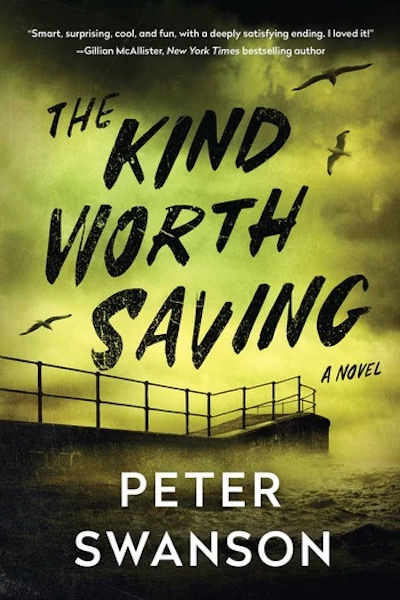I love mysteries that feature the famous, from Walt Whitman to Dorothy Parker to Eleanor Roosevelt. But featuring a living celebrity—in this case, Bernie Sanders—is even more of a challenge, one that Shaffer succeeds at wonderfully. Gen Z intern Crash Robertson is our wisecracking intern and narrator, and after months of answering phones in the DC office—from constituents who don’t know how to text?—she gets to accompany the senator on a fall-recess trip to Vermont. By chance, they head to Eagle Creek, Crash’s hometown, and end up staying in her mother’s B&B. But what has the makings of a low-key visit with constituents, and plenty of apple griddlecakes, suddenly gets upended when Crash finds the body of the local banker floating in Lake Champlain. Crash’s running commentary on Bernie—who’s always ready to deliver a lecture on the declining honeybee population, or the cozy series he’s reading, set in a cannabis bakery in the Northwest—makes for a good part of the humor in the book. But when a second citizen goes missing, it’s time for our team to get down to work. The biggest suspect is a tech-obsessed one-percenter, think Elon Musk, who’s buying up acres of maple trees, driving out local farmers, and monopolizing maple syrup production in a move Bernie dubs “Big Maple.” Unmitigated fun for everyone, no matter where they might fall on the political spectrum. Shaffer is also the author of the Obama mysteries, Hope Never Dies and Hope Rides Again.
Brian Kenney
I’ll admit it: it took me several tries to get past this novel’s disturbing opening scene, in which two women violently murder a man they just met and with whom they have zero connections. They stick him in the trunk of their car for a few hours, only to discover he’s not actually dead. Then they meticulously prep the body—who knew removing teeth to minimize identification was a thing?—and heave the now assuredly dead man over the side of a mountain. Turns out, this is just the latest murder of the serial killer sisters, identical 25-year-old triplets. Typically, their thing is to make men want them and fall in love with them. Then they kill them. It’s about a six-month process, and the first two sisters have racked up three murders each. But Sissy, our protagonist, has yet to make her first kill. She’s pulled her weight with her expertise in cleanup, removing any evidence that could connect the sisters to a murder site or a corpse. But she’s overdue in the murder department. The women have arrived in Arizona so that Sissy can focus on herself, and in no time she’s met the handsome, gentlemanly, church-going widower Edison. They quickly bond, and Sissy delights in her love affair with Edison as much as she enjoys imagining how she’ll kill him and where she’ll bury him. Until things change. Her desire to kill ebbs away, and her sisters grow increasingly anxious as they fear Sissy is pulling out of their agreement. A new, terrifying take on serial killers that will give fans the sleepless nights they crave.
Not a mystery, but darn mysterious. The Northern Institute is located somewhere in the far north, the only place on the planet where the temperature continues to drop while the snowfall continues to increase. At some point, the vast building held hundreds of scientists, who were presumably studying life in such an extreme climate. But after an unexplained incident, the great building was quickly shut down to researchers. Today, the only residents are three caretakers, led by supervisor Hart, and one remaining scientist. Contact with the world comes from a weekly mail drop that, in addition to food, gives them their assignment for the next week; testing all the doors to determine if any squeak is a prime example. Life for the caretakers is so unspeakably dull—except for Hart, who’s sadly consumed by becoming a better manager—that when a strange object appears in the snow, where there is nothing else on the horizon except snow, the caretakers become obsessed with it. Forbidden to ever go outside, the mysterious snow sickness is given as one reason, the three gaze longingly at the object. Is its color changing? Is it moving? While they are instructed to ignore the object, that eventually becomes impossible, even for manager-in-training Hart, and the three venture out to confront their visitor. A satirical take on corporate life and a darkly suspenseful tale of isolation.
We’re deep into the Second World War, and Archie Swann—the police officer on Fourth Cliff, a fishing island off the Massachusetts coast—is fighting in the Pacific theater. But his wife, Mary Beth, herself a cop trained by the Boston Police Department, has stepped into his position. While Archie was beloved, Mary Beth is loathed, largely because of her gender, and the easiest of tasks is a struggle. While the island has traditionally seen little crime—settling fights between drunk fishermen and resolving domestic disputes seemed to be the bulk of the work—things have changed under Mary Beth’s watch. The body of a soldier, who lived in a camp for Italian POWs on the island, is hauled up from the sea by fishermen, a murder that creates unrest among both islanders and prisoners. When that murder is followed by others, Mary Beth, whose supports are a doctor who is untrained as a coroner and a deputy who is intellectually disabled, turns to the only real help she can find: organized crime from the mainland. But the real story here is the internal one: Mary Beth’s loneliness, her longing for Archie, her need to always maintain a tough outer shell, her battle against feeling like a failure. Novels about women in the War have blossomed in the past few years, but few have the grittiness, honesty, and authenticity in emotion, language, and detail of Swann’s War.
Oates, Nathan. A Flaw in the Design. March, 2023. 304p. Random.
Gil and his wife are living their dream. He’s a writing professor at a small Vermont college, she’s an artist, their two daughters are as smart as they are well-behaved. Sure, money is tight, but life is rich. Until his sister and her husband die under distinctly odd circumstances and their only child, 17-year-old Matthew, comes to live with them. To say there’s history here is an understatement. Gil’s sister married way up, well into the realm of the one percenters. While the wealth disparity made for awkwardness, it’s Matthew’s crazy, violent behavior that sets everyone on edge. The last time the two families got together, seven years ago at the sister’s house in Montauk, Matthew tried to drown Gil’s youngest daughter. But Matthew 2.0 is completely different. He charms the daughters, ingratiates himself with Gil’s wife, and even signs up for Gil’s fiction-writing class. But while most of the world is taken in by this brilliant and handsome young man, Gil remains a suspicious outlier. Slowly Matthew begins to undermine Gil, submitting for class stories that fantasize about the death of Gil’s daughters and explain how Matthew’s own parents were killed. Eventually Gil is alone in believing that Matthew is a psychopath, creating a growing estrangement from his own family, who are convinced he’s fallen off the deep end. Yes, this is a thriller, but a deeply thoughtful one that skillfully plays at what is true, what is imagined, and how genius can be used in the evilest of ways.
Bakers, cozy fans, and those who just love a fun, traditional mystery will want to abandon whatever they’re doing to read this novel to its very bloody end. A mashup of the TV series The Great British Bakeoff and the film Knives Out, the book stars Betsy Martin, “American’s Grandmother,” who’s sweet as pecan pie on the outside but tough as overmixed batter on the inside. Betsy created the show Bake Week, which is filmed at her Grafton, Vermont mansion—no fear of Spotted Dick in New England, TG— which also houses the six well-drawn contestants. For years, Betsy has ruled supreme over the show, but this season she’s being forced by the producers to take on another judge to—shudder—sex things up. What could go wrong? First, someone switches the sugar and salt, then a burner “accidentally” gets set on high. In the end, the whole show comes crashing down like some deflated meringue. But you’ll hear no spoilers from me—getting to the resolution on your own is too much fun.
This is one richly drawn mystery that does a great job of introducing us to a wonderful protagonist, a compelling group of characters, and a fascinating community. Poor 28-year-old pastry chef Chloe Barnes. Not only does her engagement end up in smoke, she gets panned in a review, then learns that her beloved grandmother is being treated for cancer. Time to leave Paris and head home to Azalea Bay, California. But what to do with herself? Fortunately, her Aunt Dawn has an idea: take her fancy, pastry-making skills and apply them to cannabis to create edibles so good they can hold their heads high in the best pâtisseries. Together they begin to plan for a store, Baked by Chloe, when there’s a murder—of a creepy guy who’s loathed by most of the female population of Azalea Bay—and Aunt Dawn ends up the number one suspect. Clearing her aunt’s name draws Chloe further into the past and the community as she creates a list of suspects. The book also goes deep into the weeds (see what I did there?) as Chloe learns the complexity of cooking with cannabis. And did I mention Jake? Cute, single, and lives next door. In this debut, author George has laid the foundation for a series that feels fresh, young, and full of surprises.
Expecting a cozy retreat the likes of MacDowell or Yaddo, with the residents being slowly and genteelly knocked off? Then look elsewhere. This intimate retreat is the brain child of the renowned feminist horror writer Roza Vallo, who invites a handful of women under 30 to a month at her Victorian mansion in upstate New York. The women are all fierce Roza devotees, especially our narrator, Alex, who’s hoping the experience will help her push past a yearlong writers’ block. No sooner do they all gather for their first dinner than Roza starts revealing her crazy cards: the cohort will have to turn in 12 pages a day; read each other’s work; participate in group workshops; meet regularly with herself, Roza; and complete a novel by the end of the month. Whew! But best of all, at month’s end, a winner will receive a publishing contract for seven figures. This largesse, combined with Roza’s cruel badgering of the participants, ups the anxiety and tension in the group. But if only it stopped there. Slowly the cohort begins to come unhinged, false identities are discovered, one woman disappears in the midst of a horrendous snow storm, and everything the women hold to be true about Roza turns out to be false. This book is one hell of a wild romp.
Classic Nordic noir: a bleak, northern Swedish town; a serial killer whose victims are each murdered in the same, horrifying way; alcohol is always the drink of choice; a mother’s mind is being stolen by dementia. In Malmberget, above the Arctic Circle, houses are being relocated by a mining company—or else they’ll fall into a huge sinkhole. But as they review the empty homes, workers discover a man locked in one of the basements, barely alive. Over 600 miles south, Detective Eira Sjodin is investigating the vanishing of a middle-aged man, a much-beloved actor, whose disappearance is inexplicable. Slowly Eira is able to connect the dots, and while the man’s identity becomes clear, motive does not. Like Tana French’s work, this novel is a richly character-driven procedural, and Alsterdal digs deeply into the backgrounds of several of the detectives—examining their lives and loves. Eira’s spare time is consumed with relocating her mother to a nursing home for memory loss while recognizing that her feelings for GG, her boss, run deeper than she would like to acknowledge. But when GG goes missing, it is no holds barred as the Detective sets off on her riskiest move yet. This novel is seriously dark but at the same time absolutely compelling. While the book works as a stand-alone, readers will appreciate reading the initial title in the series, We Know You Remember, first.
A sequel of sorts to the devious The Kind Worth Killing, this novel also features PI Henry Kimball, one of the more low-key but wry detectives in the business. Central to this story is Joan, one of Henry’s students from the one year he taught high school. She pops up in his life wanting him to prove that her husband is cheating on her—a bread-and-butter job for any detective—except Henry can’t quite shake the feeling that there’s more to the story than Joan is telling. As it turns out, Joan, helped out by her buddy Richard, has been a murderer since high school–it’s the only thing that really brings the friends to life–and Swanson takes us through each of the perfect murders the team has executed. By the time we get back to the present, it’s clear that there’s a whole lot more in store for Henry than he would ever have imagined. Swanson is such an adroit novelist, moving us smoothly from present to past and back again, building up the tension, stoking the anxiety, all while interjecting some perverse humor through the characters and their observations. And kudos for such a surefire depiction of the Boston suburbs. Reading the earlier book first would be slightly helpful, but this still works as a standalone. Wickedly delicious!










